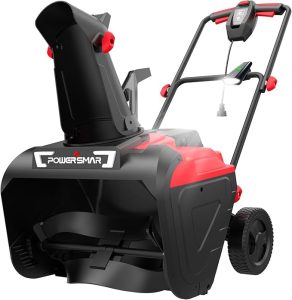
When it comes to clearing snow from your driveway or walkway, an electric snow blower can be a convenient and eco-friendly option. However, to ensure you’re getting the right machine for your needs, it’s crucial to understand electric snow blower amp ratings and how they affect performance. Let’s dive into the world of amp ratings and explore their significance in choosing the perfect snow blower for your winter battles.
What Are Electric Snow Blower Amp Ratings?
Electric snow blower amp ratings refer to the amount of electrical current the machine draws during operation. The amp rating is a key indicator of the snow blower’s power and capacity to handle various snow conditions. Typically, electric snow blowers range from 10 to 15 amps, with higher amp ratings generally translating to more powerful performance.

EGO Power+ SNT2405
How Amp Ratings Affect Performance
The amp rating of an electric snow blower directly impacts its ability to clear snow efficiently. Higher amp ratings usually correlate with:
1. Increased throwing distance: Snow blowers with higher amp ratings can often throw snow farther, allowing for more efficient clearing of large areas.
2. Wider clearing paths: More powerful motors can handle wider augers, resulting in broader clearing paths and fewer passes to complete the job.
3. Better handling of heavy, wet snow: Higher amp ratings provide more torque, enabling the machine to power through dense, moisture-laden snow more effectively.
4. Faster clearing speeds: With more power at their disposal, high-amp snow blowers can often clear snow more quickly than their lower-amp counterparts.
Choosing the Right Amp Rating for Your Needs
When selecting an electric snow blower, consider the following factors to determine the appropriate amp rating:
1. Average snowfall in your area: If you live in a region with frequent heavy snowfall, opt for a higher amp rating to ensure your snow blower can handle the workload.
2. Property size: Larger properties may benefit from higher amp ratings to clear snow more efficiently and reduce overall clearing time.
3. Snow type: If you often deal with wet, heavy snow, a higher amp rating will provide the necessary power to tackle these challenging conditions.
4. Electrical circuit capacity: Ensure your home’s electrical system can support the amp rating of the snow blower you choose. Most household circuits are rated for 15 or 20 amps, so be mindful of other appliances that may be running on the same circuit.
Popular Electric Snow Blower Amp Ratings
Here are some common amp ratings you’ll encounter when shopping for electric snow blowers:
10-12 Amps: Suitable for light to moderate snowfall and smaller properties. These models are often more compact and easier to maneuver.
13-15 Amps: Ideal for moderate to heavy snowfall and medium-sized properties. These snow blowers offer a good balance of power and efficiency.
15+ Amps: Best for heavy snowfall, large properties, and challenging snow conditions. These high-powered models can handle the toughest winter weather.
Maximizing Performance Regardless of Amp Rating
While amp ratings are important, proper maintenance and usage can help maximize your electric snow blower’s performance:
1. Keep the auger and chute clean and free of debris.
2. Use an appropriate extension cord rated for outdoor use and the snow blower’s amp rating.
3. Clear snow frequently during storms to prevent buildup and overworking of the machine.
4. Store your snow blower in a dry, protected area when not in use to prevent corrosion and damage.
Understanding electric snow blower amp ratings is crucial for choosing the right machine for your winter snow-clearing needs. By considering factors such as snowfall, property size, and snow type, you can select a snow blower with the appropriate amp rating to tackle whatever winter throws your way. Remember that while higher amp ratings generally indicate more powerful performance, proper maintenance and usage practices are equally important in ensuring your electric snow blower serves you well for many winters to come.








